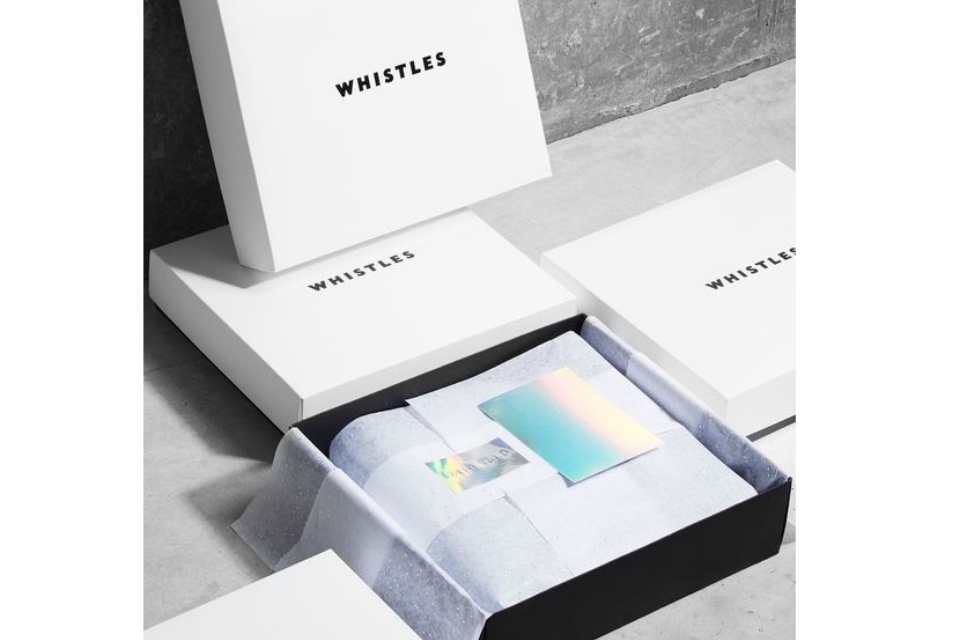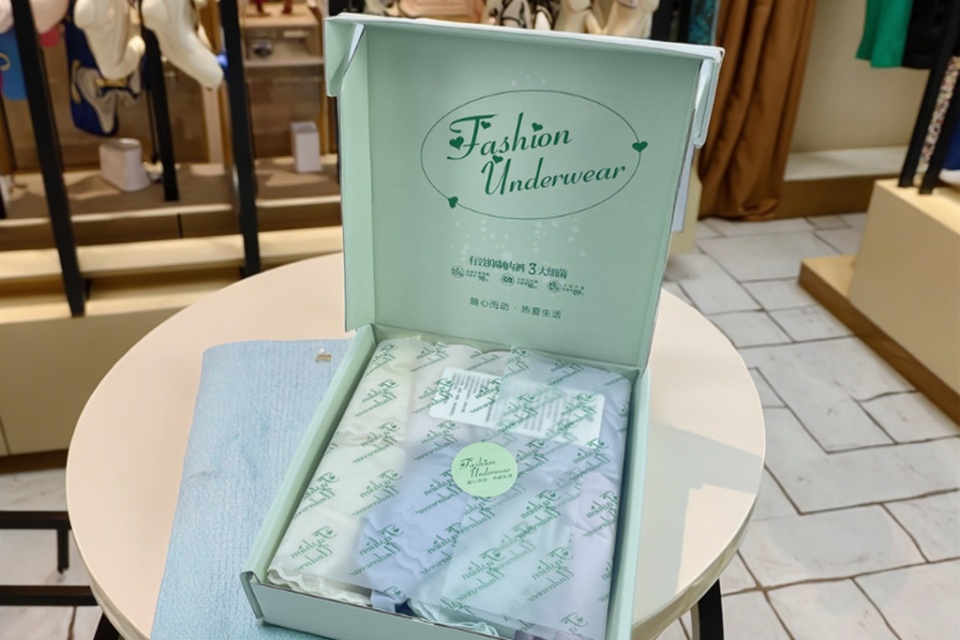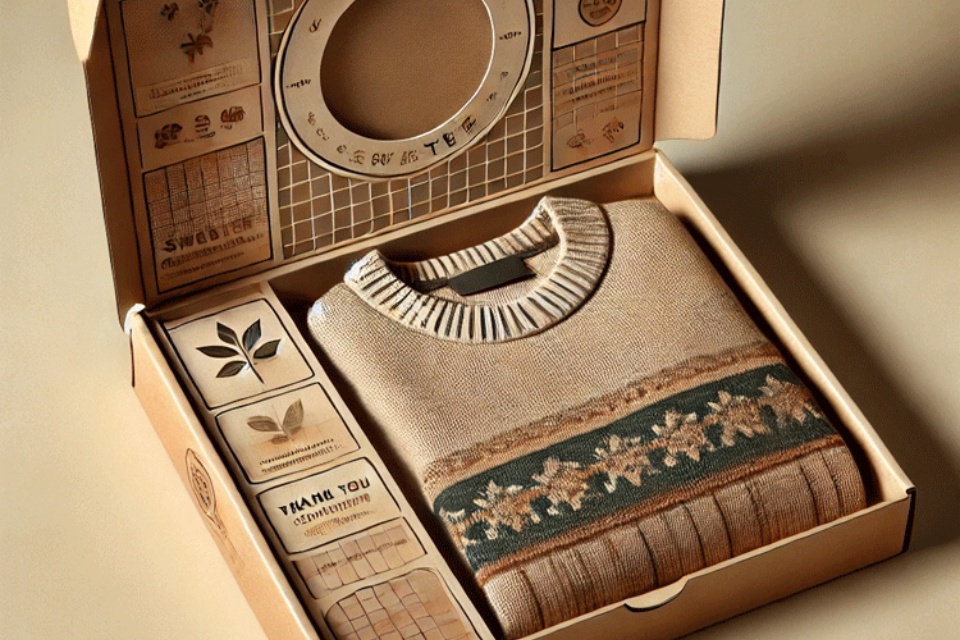Industry News
Using Custom Tissue Paper, Stickers, And Ribbons In Apparel Boxes
Using Custom Tissue Paper, Stickers, And Ribbons In Apparel Boxes
Summary
Custom tissue paper stickers and ribbons are increasingly recognized as essential components of packaging in the apparel industry, enhancing both aesthetic appeal and brand identity. These decorative elements serve multiple functions, from providing an elegant presentation for apparel boxes to improving customer experience during the unboxing process. The trend towards personalized and visually appealing packaging reflects broader consumer preferences for unique and memorable shopping experiences, especially in the context of e-commerce.
The use of custom tissue paper and ribbons not only contributes to the branding and marketing strategies of companies but also addresses practical concerns such as protecting delicate items during shipping. By incorporating unique designs, logos, and colors, brands can create a cohesive and visually striking presentation that reinforces customer loyalty and encourages repeat purchases. Additionally, these custom packaging solutions align with growing consumer demand for sustainability, as many companies are opting for biodegradable or recycled materials that resonate with environmentally-conscious shoppers.
However, the integration of custom tissue paper and ribbons into packaging also presents challenges, including higher costs associated with sustainable materials and the complexities of supply chain logistics. As businesses strive to balance aesthetic appeal with eco-friendly practices, misconceptions surrounding the sustainability of packaging materials may further complicate consumer perceptions. Despite these hurdles, the trend towards thoughtful packaging continues to evolve, reflecting a cultural shift towards greater environmental responsibility and enhanced consumer engagement.
Overall, custom tissue paper stickers and ribbons represent a significant innovation in apparel packaging, influencing consumer behavior and brand perception while fostering emotional connections through the unboxing experience. As brands increasingly prioritize sustainable practices and creative design, these packaging elements are poised to play a pivotal role in shaping the future of the industry.
History
Ancient Packaging
The origins of packaging can be traced back to the earliest human societies, where natural materials such as leaves, animal skins, and plant fibers were used to contain and transport goods. This rudimentary form of packaging served essential functions such as protection and preservation, enabling communities to store food and other items effectively. As trade routes like the Silk Road emerged, the need for more sophisticated packaging solutions became apparent, paving the way for innovations in materials and techniques.
Development Through the Ages
The history of packaging saw significant advancements during the Middle Ages, with the introduction of materials such as glass and ceramics, which allowed for better preservation of goods. By the 18th century, paper-based packaging began to gain popularity, thanks in part to improvements in papermaking technology introduced by the Moors in Europe, leading to the establishment of notable paper manufacturers like the Fabriano company in Italy.
As the Industrial Revolution progressed, mass production changed the landscape of packaging, introducing standardized containers and labels that not only served practical purposes but also began to play a crucial role in branding and marketing. This era marked a shift where packaging evolved from merely a protective layer to a vital component of consumer interaction with products, influencing purchasing decisions significantly.
The Rise of Plastic and Modern Innovations
The introduction of plastic packaging in the mid-20th century revolutionized the industry, offering durability, cost-effectiveness, and versatility. Since the 1970s, the use of plastic has surged, replacing many traditional packaging materials. However, this shift has also raised environmental concerns due to the persistence of plastics in landfills and oceans, leading to growing consumer demand for sustainable alternatives.
In response, the packaging industry has witnessed a resurgence in the use of eco-friendly materials and designs, such as biodegradable options and minimalist packaging. These modern innovations are not only aligned with consumer preferences for sustainability but also reflect a broader awareness of environmental issues and their implications for product lifecycle management. Today, brands are increasingly embracing custom packaging solutions, such as tissue paper stickers and ribbons, which not only enhance the aesthetic appeal of apparel boxes but also contribute to a brand's identity and marketing strategy.
Applications
Custom tissue paper stickers and ribbons play a significant role in enhancing the overall presentation and branding of apparel boxes. They serve multiple functions that contribute to both aesthetic appeal and practical utility.
Branding and Personalization
Custom tissue paper stickers provide an excellent opportunity for brands to enhance their identity. By incorporating personalized stickers that feature logos, brand colors, or unique designs, companies can create a memorable unboxing experience for customers. This personalized touch reinforces brand recognition and loyalty, making it more likely for consumers to return for future purchases.
Protective Functionality
In addition to their decorative role, custom tissue paper can offer a layer of protection for delicate apparel items. Wrapping clothing with tissue paper helps prevent damage during shipping, such as creases or snags, ensuring that the product reaches the customer in pristine condition. Moreover, biodegradable tissue paper aligns with sustainable practices, appealing to environmentally-conscious consumers.
Gift Packaging
Ribbons are often used in conjunction with custom tissue paper to create an elegant presentation for apparel items, particularly for special occasions or as gift options. The combination of tissue paper and ribbons not only adds visual appeal but also enhances the perceived value of the product, making it an attractive option for gifting. This attention to detail can differentiate a brand in a competitive market, leading to increased customer satisfaction.
Enhanced Unboxing Experience
The unboxing experience is critical in e-commerce, and using custom tissue paper stickers and ribbons can significantly elevate it. An aesthetically pleasing package can create excitement and anticipation as customers open their orders. This experience is further enhanced by the tactile qualities of high-quality tissue paper and the elegance of ribbon finishes, fostering positive associations with the brand.
Practical Uses in Shipping
In the context of shipping, custom tissue paper stickers can be employed to seal boxes securely, ensuring that items remain intact during transit. Additionally, these stickers can convey essential information, such as handling instructions or return policies, making them functional as well as decorative.
Benefits
Using custom tissue paper, stickers, and ribbons in apparel boxes offers a myriad of advantages that enhance both brand perception and customer experience.
Enhanced Aesthetic Appeal
Custom-printed tissue paper significantly improves the overall aesthetic of packaging, making it visually appealing and sophisticated. This can evoke feelings of luxury and enhance the unboxing experience, which is increasingly important in consumer purchasing decisions. Brands that utilize creative designs and unique wrapping can make a lasting impression, ultimately boosting customer satisfaction and loyalty.
Improved Customer Experience
The tactile and visual elements of custom tissue paper contribute to a memorable customer experience. When consumers receive a beautifully packaged product, it heightens their emotional response, making them more likely to share their experience with others, thus generating word-of-mouth marketing. Furthermore, customized elements such as themed stickers or ribbons can personalize the packaging, showing that extra thought has been put into the presentation.
Brand Recognition and Perception
Incorporating custom tissue paper and stickers helps to establish and reinforce brand identity. Consistent use of specific colors, designs, or logos can deepen brand messaging and recognition among consumers. This helps differentiate a brand in a crowded market, as effective packaging design plays a crucial role in attracting and retaining customers. Research indicates that packaging influences 70% of buying decisions at the point of sale, underscoring its importance in shaping brand perception.
Cost-Effective Marketing
Custom tissue paper and ribbons are affordable options for enhancing product packaging without significantly increasing costs. They add value to the packaging while being relatively inexpensive compared to other marketing strategies. This makes them a popular choice for businesses of all sizes, from small retailers to large e-commerce platforms.
Sustainability Considerations
As consumer awareness of sustainability rises, incorporating eco-friendly materials in custom tissue paper and packaging can also enhance brand reputation. Many consumers now prioritize brands that demonstrate a commitment to sustainable practices, with 77% considering recyclability extremely important. Using biodegradable or recycled materials in packaging aligns with these values, appealing to environmentally-conscious shoppers and potentially increasing market share.
Design and Production
Influence of Cultural and Creative Industries
The integration of cultural and creative industries significantly impacts the design of packaging, including apparel boxes. This influence manifests through innovative and unique packaging designs that reflect cultural narratives and consumer preferences. As brands strive to differentiate their products, the aesthetic and emotional resonance of packaging becomes crucial for attracting and retaining customers.
Role of Packaging Engineers
Packaging engineers play an essential role in the design and production of apparel packaging. They are tasked with creating visually appealing and functional designs that protect the contents while also evoking emotions in consumers. This involves careful consideration of materials, printing techniques, shapes, and textures to ensure that the packaging is both practical and visually enticing.
Material Selection and Innovation
The choice of materials is fundamental to the production of apparel packaging. Traditional materials like paper and cardboard have been enhanced with the advent of plastics, which offer durability and versatility. Custom tissue paper, in particular, is gaining popularity due to its premium feel and ability to elevate the unboxing experience. This paper can be paired with branded boxes, ribbons, and stickers to create a cohesive packaging solution that reinforces brand identity.
Sustainability Considerations
In recent years, the fashion industry has increasingly focused on sustainable packaging solutions. Innovations in textile processing and material selection have highlighted the importance of reducing the environmental impact of packaging. Brands are encouraged to adopt next-generation materials that minimize emissions and waste while still providing an attractive packaging option.
Creative Approaches to Packaging Design
To effectively engage consumers, packaging design must go beyond functionality. Innovative packaging that incorporates cultural elements or practical reuse options can significantly enhance consumer interest. For example, designs that can be repurposed or have secondary uses after the initial function can foster a deeper connection with the product and brand, leading to increased sales and customer loyalty.
Trends
Evolving Consumer Preferences
Recent studies indicate a significant shift in consumer preferences towards sustainability. A McKinsey survey found that 50% of consumers rank sustainability as a top purchase criterion, demonstrating an increasing willingness to change habits in favor of eco-friendly options. This trend is particularly influential in the packaging industry, where businesses are pressured to innovate and adopt sustainable practices to meet consumer demand for environmentally responsible products. Notably, products making Environmental, Social, and Governance (ESG)-related claims have seen an average growth of 28% over five years, outperforming those without such claims.
Cultural Dynamics in Packaging
Understanding cultural nuances is crucial for effective packaging design. What may be appealing in one culture could be viewed as outdated in another. This requires brands to conduct ongoing cultural research and remain sensitive to local market trends. Packaging not only reflects cultural history but also serves as a forward-looking indicator of emerging societal trends. Designers must consider the cultural significance of symbols and color associations, as these can greatly influence consumer perception and purchasing decisions.
Material Innovation
The shift towards sustainable packaging is also driven by advances in material technology. Traditional materials, such as plastic and Styrofoam, are increasingly being replaced by recycled paper, cardboard, plant-based plastics, and compostable materials, which contribute to a circular economy. Furthermore, the fashion industry is actively seeking next-generation materials to reduce its environmental impact, recognizing that material choices account for a significant portion of industry emissions. Brands that invest in these innovations not only enhance their environmental stewardship but also improve their market appeal.
Design Approaches and Aesthetic Appeal
Incorporating sustainable practices into packaging design is not limited to material selection; it also involves adopting innovative design approaches that enhance efficiency. Minimalist packaging, which emphasizes simplicity and functionality, is becoming more popular as it reduces waste and can enhance the overall brand aesthetic. Moreover, the use of striking visual designs, such as bold black and white contrasts, can create a lasting impression while reinforcing a brand's identity and values.
By aligning their packaging strategies with these trends, brands in the apparel sector can better resonate with environmentally conscious consumers while maintaining a strong market presence.
Case Studies
Family Tradition and Reuse
Ingrained family traditions can significantly influence consumer behavior and perceptions of packaging. For instance, a respondent named Ingrid, born in 1976, highlights how canning remains a common practice in her family, with many jars and bottles reused from her deceased parents. This generational reuse of packaging not only preserves materials but also strengthens familial connections through the objects that embody shared history and practices. As noted by Ian Hodder, materials possess distinct temporalities and lifecycles that differ from those of humans, suggesting that packaging can serve as a bridge across generations, thus enhancing its perceived value and significance within families.
Custom Packaging and Brand Perception
The strategic use of custom packaging, particularly in the apparel sector, has been shown to enhance brand communication and create memorable unboxing experiences. For example, brands that employ custom tissue paper and unique designs in their packaging can profoundly impact customer perceptions, establishing a sense of luxury and excitement upon unboxing. This approach not only contributes to immediate consumer satisfaction but also fosters brand loyalty, as consumers often return to brands that deliver engaging and aesthetically pleasing packaging experiences.
Sustainability and Consumer Choice
Sustainable packaging has emerged as a critical factor influencing consumer choices, with many consumers motivated by values that align with their beliefs regarding environmental stewardship. A survey indicated that brands making Environmental, Social, and Governance (ESG) claims on their packaging tend to outperform those that do not, demonstrating a growing consumer preference for companies committed to sustainability. This trend underscores the importance of integrating eco-friendly materials and practices into packaging design, as consumers increasingly prioritize brands that reflect their values and contribute positively to society.
Emotional Engagement through Packaging
The emotional connections formed through thoughtful packaging can significantly impact customer loyalty. The aesthetic appeal of custom tissue paper, for instance, not only elevates the visual quality of the packaging but also enhances the emotional experience for the consumer. This strategic choice can transform a simple product delivery into a memorable moment, reinforcing the consumer's positive association with the brand and encouraging repeat purchases. Research suggests that effective branding through packaging can enhance customer perception and encourage emotional engagement, ultimately influencing purchasing decisions and brand loyalty.
Challenges
Sustainable packaging, particularly in the context of custom tissue paper stickers and ribbons used in apparel boxes, faces several significant challenges that companies must navigate to implement effective eco-friendly solutions.
Cost Considerations
One of the primary hurdles is the higher costs associated with sustainable materials and production processes. Many eco-friendly alternatives, such as biodegradable or compostable materials, can be more expensive than traditional packaging options, which poses a financial barrier for businesses, especially smaller ones looking to adopt sustainable practices. While some brands may perceive sustainable packaging as a premium option, it is essential to evaluate the total costs, considering potential savings from reduced material usage and operational efficiencies in the long term.
Supply Chain Complexities
The transition to sustainable packaging also involves navigating complex supply chain issues. Companies often face challenges related to the availability and sourcing of eco-friendly materials, as well as ensuring compatibility with existing manufacturing processes. The need for reliable suppliers who can provide sustainable options consistently adds another layer of complexity. Moreover, the infrastructure for recycling and composting such materials varies significantly across regions, complicating logistics and limiting the effectiveness of sustainable packaging efforts.
Consumer Misconceptions
Educating consumers about sustainable packaging is another critical challenge. Many consumers conflate “sustainable” with “premium,” leading to misconceptions about the true environmental impact of different packaging options. Brands must not only provide sustainable choices but also engage in clear, transparent communication to help consumers understand the benefits of eco-friendly materials and practices. This education is crucial as consumers increasingly prioritize sustainability in their purchasing decisions; 78% of U.S. consumers consider living a sustainable lifestyle important, highlighting the need for informed consumer behavior.
Balancing Functionality and Sustainability
Additionally, companies must strike a balance between functionality and sustainability. Custom tissue paper stickers and ribbons need to meet aesthetic and functional requirements while also adhering to eco-friendly standards. Innovative design approaches, such as minimalist packaging, can help reduce waste and enhance the overall brand aesthetic, but finding the right balance can be challenging.
Categories
Latest News
Contact Us
Contact: Aaron Lee
Phone: +8613570866244
Tel: +8675529490260
Add: Li Songlang 2nd Industrial Zone,No.18,FengTang Rd,Guangming New District


